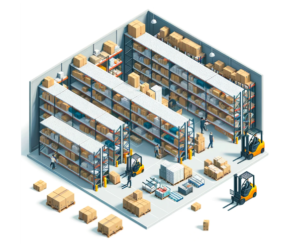Introduction
In the realm of logistics and supply chain management, warehouses play a pivotal role in ensuring the smooth flow of goods from manufacturers to consumers. Efficient warehouse management can significantly impact a company’s bottom line, customer satisfaction, and overall operational success. This article will explore how warehouses are classified based on their area and scale, and delve into the unique challenges and strategies involved in managing small, medium, and large warehouses.

Classification of Warehouses
Warehouses can be broadly categorized based on their size and operational scale. These classifications help in understanding the specific needs and management strategies required for each type.
- Small Warehouses: Typically, these are warehouses with an area of less than 50,000 square feet. They are often used by small businesses or as regional distribution centers.
- Medium Warehouses: Ranging from 50,000 to 200,000 square feet, these warehouses serve mid-sized companies or larger companies needing additional storage capacity.
- Large Warehouses: Exceeding 200,000 square feet, large warehouses are used by major corporations and serve as central hubs in the logistics network.
Managing Small Warehouses
Small warehouses, though limited in space, require a high level of efficiency and organization. Here are some key strategies for managing small warehouses:
- Space Optimization: Utilize vertical space effectively by installing high shelves and racks. Implement narrow aisle configurations to maximize floor space. Consider using mezzanine floors to create additional storage space.
- Inventory Management: Employ a robust inventory management system to keep track of stock levels, reduce excess inventory, and minimize stockouts. Cycle counting can be an effective method to ensure inventory accuracy without needing to shut down operations for a full inventory count.
- Technology Integration: Integrate Warehouse Management Systems (WMS) to streamline operations, track inventory in real-time, and automate routine tasks. Mobile scanning devices and barcode systems can greatly enhance accuracy and speed in inventory management.
- Flexible Workforce: Employ a flexible workforce that can adapt to varying workloads. Cross-training employees can ensure that all tasks are covered even during peak periods. This flexibility can also help in reducing labor costs by adjusting the workforce according to demand.
- Efficient Receiving and Shipping: Implement efficient receiving and shipping processes to minimize turnaround time and ensure quick order fulfillment. Standard operating procedures (SOPs) for these processes can help maintain consistency and efficiency.
Managing Medium Warehouses
Medium-sized warehouses strike a balance between space and operational complexity. Effective management of these warehouses involves:
- Layout Planning: Design a layout that facilitates smooth flow of goods, from receiving to storage to shipping. Consider implementing dedicated zones for different activities, such as bulk storage, pick-and-pack areas, and shipping docks. Utilizing a U-shaped or L-shaped layout can streamline the movement of goods and reduce handling times.
- Advanced WMS: Utilize advanced WMS that offers features like automated replenishment, order picking optimization, and real-time data analytics. These systems can help manage more complex operations and provide insights that drive efficiency.
- Workforce Management: Develop a structured workforce management plan, including shift scheduling, performance monitoring, and continuous training programs. Implementing labor management systems (LMS) can help track productivity and identify areas for improvement.
- Inventory Turnover: Focus on improving inventory turnover rates by optimizing stock levels and using techniques like Just-In-Time (JIT) inventory management. This can help reduce holding costs and ensure fresher inventory.
- Safety Protocols: Establish strict safety protocols to protect workers and goods, including regular training sessions and safety audits. Safety measures like proper labeling of hazardous materials, use of personal protective equipment (PPE), and regular maintenance of equipment are crucial.
Managing Large Warehouses
Large warehouses, due to their scale, present unique challenges that require sophisticated management strategies:
- Automated Systems: Invest in automated systems such as Automated Storage and Retrieval Systems (AS/RS), conveyor systems, and robotics to handle large volumes of goods efficiently. These systems can significantly reduce labor costs and increase accuracy and throughput.
- Data-Driven Decisions: Leverage big data and advanced analytics to make informed decisions on inventory management, layout optimization, and demand forecasting. Predictive analytics can help anticipate trends and adjust inventory levels accordingly.
- Scalable Solutions: Implement scalable solutions that can grow with the business, including flexible storage solutions and scalable WMS. Modular racking systems and adaptable technology infrastructure can support expansion and changes in product lines.
- Energy Efficiency: Focus on energy efficiency by implementing green practices such as LED lighting, energy-efficient HVAC systems, and renewable energy sources. Energy management systems (EMS) can help monitor and reduce energy consumption.
- Comprehensive Training Programs: Develop comprehensive training programs for employees to ensure they are proficient in using advanced technologies and understand the latest industry practices. Continuous education and certification programs can help maintain a skilled and motivated workforce.
Conclusion
Effective warehouse management is crucial for the success of any business involved in logistics and supply chain operations. By understanding the unique needs and challenges of small, medium, and large warehouses, companies can implement tailored strategies to optimize their operations, improve efficiency, and reduce costs. Embracing technology, such as Warehouse Management Systems, and focusing on continuous improvement can help businesses stay competitive in an ever-evolving market.
As a market operations specialist, highlighting these insights can position your company as a thought leader in warehouse management. This not only attracts potential clients but also helps existing customers optimize their own operations. Stay informed, stay efficient, and keep driving innovation in warehouse management.




